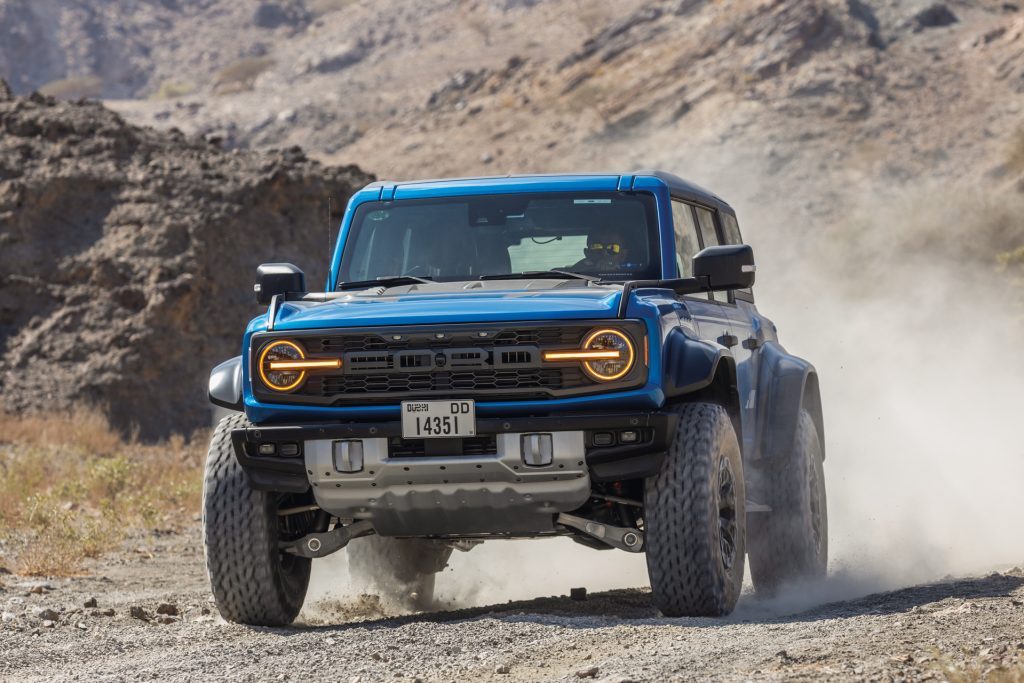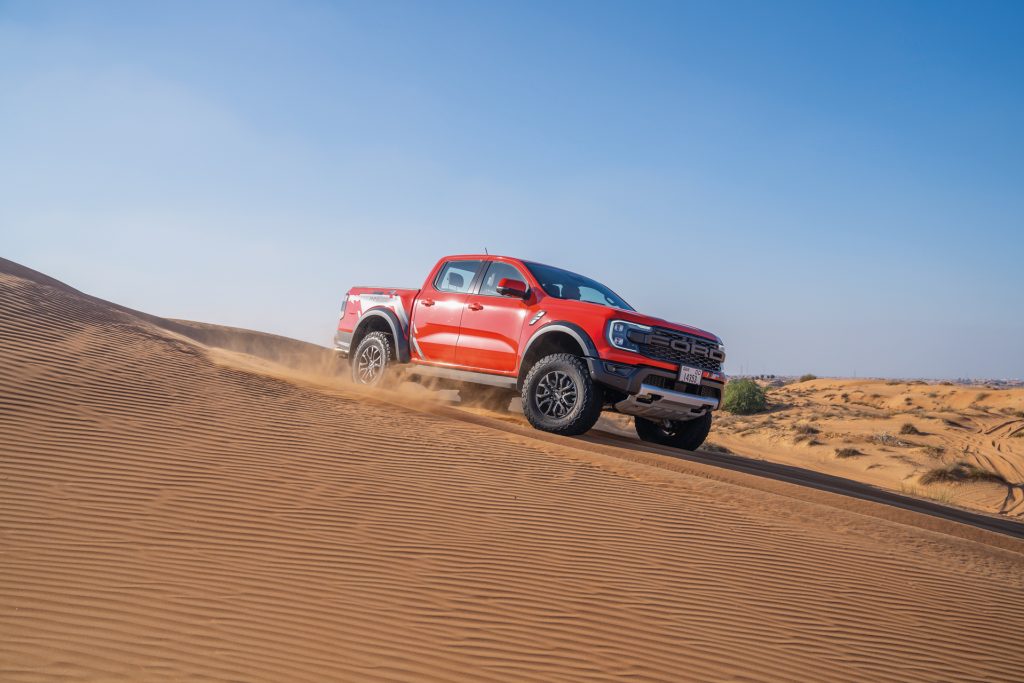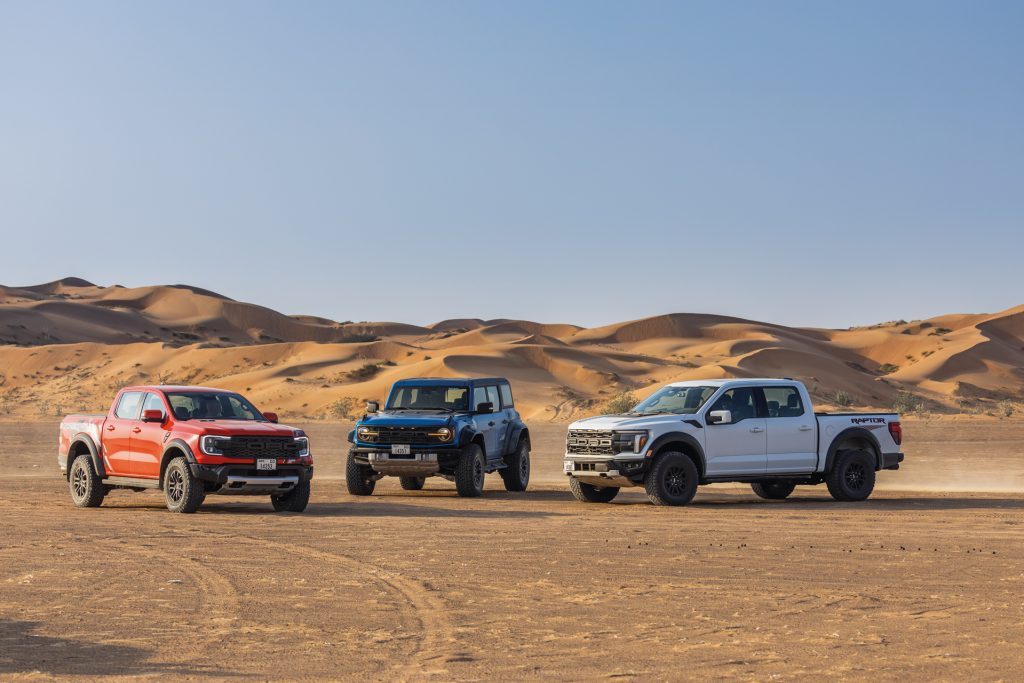We travel to the Dubai desert to check out the F-150, Bronco and Ranger Raptor models in the type of environment that they were built to conquer.
Ford CEO, Jim Farley, recently stated; “Rule No. 1 at Ford: no boring products.”
Farley had previously said that he doesn’t want Ford building boring cars for the masses. “We are not going to be playing in the two-row commodity crossover market. Ford’s tried that in the ICE business and it didn’t really work out for us.” And so Ford will focus on commercial vehicles and ‘passion products’.
“At Ford, we make products for people who work and we make passion products like Bronco and Mustang. “We want Ford to be a powerhouse when it comes to passion products and work products. No more boring products.”
To emphasise the point, Farley’s X account has the hashtag: ‘NoBoringProducts’. Farley even went so far as to say he wants Ford to be seen “as the Porsche of off-road”.
And with cars like the Mustang GTD giving the Porsche 911 GT3 RS a run for its money, it is clear Ford doesn’t just have its scope set firmly in the mud.
So what’s leading Ford’s charge to become the greatest off-road manufacturer? The Raptor of course. Here in New Zealand Raptors have been prowling our roads since 2018, but the history of the bright orange desert racer goes back further, 15 years in fact, with the 2010 F-150 SVT Raptor.
Engineers internally named it Raptor, referring to those menacing dinosaurs from Jurassic Park and a bird of prey that primarily hunts vertebrates. The marketing team and journos agreed and the name stuck. Ford has produced three generations of F-150 Raptor and two lines of Ranger Raptor. Now there is a Bronco Raptor too.
The objective of Raptor was simple; build the ultimate off-road vehicle, one that could compete in the Baja 1000. And it’s a race where F-150, Bronco and Ranger have all won their respective categories in the stock classes over the years. The recipe has remained largely unchanged for Raptor; more power, a wider body and track, chassis strengthening, those famous Fox shocks and massive BF Goodrich tyres.
Even though all three models receive the special Raptor recipe, each is developed with a certain aspect of off-roading in mind. The F-150 is big, a super GT that can go anywhere in a desert setting. Yet it’s also a practical workhorse with everything you need for the job site while moonlighting as a desert racer on the weekends.
Bronco uses a shortened version of the T6 platform shared with the Ranger. It is also much wider with those massive mud flares and simply enormous 37-inch tyres. The suspension is set for maximum travel with rock climbing in mind; this thing is an off-roader’s dream. It’s the most off-road-focused vehicle here and the most outrageous.
The Ranger is the smallest truck and it’s the all-rounder; it can climb and jump and is more agile on undulating courses. Plus it can still perform the commercial duties of a ute, albeit with a slightly reduced payload and towing capacity compared with a regular Ranger.
Ford sent us to Dubai to check out these machines in the environment they were designed to conquer. To show each model’s superpowers, Ford picked out three different courses. These showcased the strengths of each vehicle. The F-150 route featured flowing desert trails and dunes while the Bronco headed for the hills for some rock crawling. Meanwhile, the Ranger’s course featured tighter trails and technical terrain with some high-speed desert runs.

Climbing into the massive F-150, the interior is well appointed with a 12-inch touchscreen featuring over-the-air updates, B&O hi-fi, and charge ports everywhere with all plug types accounted for. There’s also a foldable gear shifter that allows the armrest to double as a work desk. And there are lovely looking heated and vented Recaro seats.
The (D35) twin-turbo 3.5L Ecoboost V6 is a beast. It’s the same engine as that in the Ford GT but detuned to 335kW and 692Nm. Still, it makes 41kW more than the Gen 2 Raptor and an extra 55Nm of torque. A new three-inch X-pipe exhaust with active valves sounds very angry. It also gets a higher-power cooling system, which didn’t skip a beat. We had all three machines running for most of the day with the A/C on, keeping the interiors cool under the Dubai desert sun.
The leaf springs out back have been replaced with a five-link set-up featuring massive trailing arms, a panhard rod and 24-inch coil springs. The Fox shocks get continuously variable compression dampening of up to 450kg per corner.
We headed south from our base in the desert on some dusty gravel roads. Large packs of camels didn’t seem too fussed about getting out of our way. Eventually, we left the gravel road for the sandy stuff, lining up for some high-speed runs. The F-150 has seven drive modes; Normal, Sport, Slippery, Tow/Haul, Rock Crawl, Off-Road, and Baja. Launching the F-150 in Baja mode, the exhaust kicks up a notch as the truck throws up sand from those supersized 35-inch BF Goodrich tyres. Lift off the pedal and the anti-lag kicks in for three seconds to keep the turbos on boost.
Moving on we traveled on winding trails heading deeper into the desert before arriving at some bigger dunes to climb. Floor it, and the Raptor sorts the rest, pulling itself through deep sand. The biggest Raptor is a beast, the DNA of the F-150 is similar to that of the Ranger, only there’s more of everything.

Into the Bronco, and we headed out east towards the border with Oman, to the northern tip of the Hajar Mountains. The Bronco shares the same twin-turbo 3.0L V6 as the Ranger but as this 4×4 sits on a shorter 2960mm wheelbase (310mm less than Ranger’s), its abbreviated exhaust allows it to make 307kW and 596Nm, up on Ranger’s 292kW and 583Nm. However, its substantial kerb weight of 2600kg is 125kg more than that of the Ranger, negating any power advantage.
Front suspension components like the hubs and lower arms are shared with the F-150 Raptor. Ford Performance has beefed up the axles, drive shafts, cross bars, frame and top struts. The Fox shockers come with Live Valve technology. Like the others they are Teflon infused with a 3.1-inch shock and semi-active dampers. There are integrated reservoirs in the front and remote reservoirs in the rear.
The Bronco’s seven drive modes controlled by the GOAT (Goes Over Any Terrain) dial are Normal, Sport, Slippery, Rock Crawl, Tow/Haul, Off-Road and Baja.
On the inside, it has pleasing details like a carbon fibre steering wheel, shifter and grab handles while our Bronco had optional leather and ultrasuede seats which proved comfortable and hold you well. Marine-grade vinyl seats and washable rubber floor mats are standard if getting muddy is your thing.
As we travelled down the highway towards the mountains, the boxy shape of the Bronco produced a bit of road noise, amplified by the fact that the roof and doors are removable.
Once we got to the mountains, we shifted the Bronco into Rock Crawl mode. Buttons on the top of the dash allow you to easily lock the front or rear diffs while the Trail Control switch, an off-road cruise control, lets you set the speed and focus on the steering. Trail Turn Assist brakes the inside rear wheel, helping you rotate the vehicle in tight spots. Trail One Pedal Drive allows for greater speed control without having to resort to the brake pedal.
Bronco has a ground clearance of 330mm and minimal front and rear overhangs that aid in navigating the rocky terrain. The suspension travel is 330mm in the front and 355mm rear allowing you to traverse some serious terrain while keeping the wheels planted.
Straight out of the box, the Bronco is the perfect off-road toy. You can tell the people at Ford are enthusiasts having thought out so many details, as it’s fully equipped. For other brands you’d have to go aftermarket to compete with its capabilities. However, should you want to modify it further, Ford has thought of that too, with upfitter switches near the rearview mirror (like the Ranger and F-150 get). These allow you to add accessories such as a light bar or recovery winch. The leading edge of the rear wheel flare is replaceable should you damage it on a narrow trail. Hood tie downs and camera charge points and mounts on the top of the dash are a few of the enthusiast-driven details that make this car so well thought out.
Who wouldn’t want to have any one of these glorious desert racers parked on their driveway? The Ranger is the pick of the bunch. Happily, it is the only one of the trio available in New Zealand.

Unlike the previous Ranger, this one was designed from the start with a Raptor version in mind. It has almost double the power of the previous 2.0L diesel, giving it the grunt to match its chassis. We headed into the desert navigating some twisting tracks and powering through dunes and deep sand. This is where the extra power comes into play. Not having to build the momentum, you can plant it and the power will pull you out of the dunes. It makes you question whether you could have done that in its predecessor.
The 33-inch tyres are the smallest of the trio but are suited to the Ranger’s size. It also gets seven drive modes like the F-150 and Bronco but Tow/Haul and Off-road settings are replaced with Mud/Ruts and Sand modes. However, the rest are the same. Each mode tweaks the exhaust, steering, throttle, drivetrain, ABS and stability control, optimising it for the environment. Customisation is the name of the game in Ranger Raptor and you can adjust each mode further, switching the four-wheel drive systems and locking the front or rear diffs. You can also turn off safety systems to make it ‘yobbo’ as you like. Hold the R button on the wheel to save your favourite set-up, creating a quick shortcut to access it on future drives.
The Raptor is not just a great off-roader, the ride in the Raptor on tarmac is very comfortable; speed bumps, potholes and rough roads don’t faze it. The 2.5-inch Fox live-valve shocks are smarter than ever, taking on all surfaces in their stride.

Who wouldn’t want to have any one of these glorious desert racers parked on their driveway? While it would be nice to have the choice of all three, the smaller, lighter and more agile Ranger is the pick of the bunch. Happily it is the only one of the trio available in New Zealand.
It’s more suited for our roads, being designed and developed in Australia. I don’t believe you’d stand a chance of angle parking in a 2176mm wide Bronco Raptor.
The appeal of the Ranger Raptor hits even harder when you compare prices. F-150’s pricing starts at $140,913 and the Bronco is $157,019 NZD, an increase of $35,000 from when it first went on sale (if you could get on the wait list) back in 2022. The Ranger’s $96,490 asking price ($86,990 for the diesel) by comparison makes it a bargain and a tempting upgrade over the $76,990 Wildtrack. If you’re okay with more visits to the pump the Raptor is well worth it.
Will Ford’s strategy of leaving the boring cars for other brands and focusing on exciting enthusiast cars and work vehicles pay off? Well, the fact the Ranger has been the best-selling vehicle in NZ for the past 10 years tells us that they’re doing exactly what Kiwis want.


